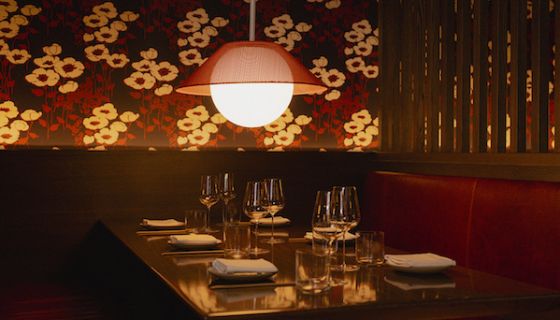Everybody appears to be chasing the titans of the Manhattan restaurant business. There are landlords with previously thriving retail property trying to do a deal. There are, of course, hoteliers who can provide crucial breakfast and late-night business. And both of these have been recently joined by a plethora of newer but equally interested parties as the city’s building boom continues unabated.
There is the massive redevelopment on the West Side known as Hudson Yards. The admitted investment figure of US$25 billion (£19.5 billion) gives some idea of the size of this scheme – although it probably has to be visited to be fully appreciated.
There are over 20 restaurants in this ambitious development, ranging from Mercado Little Spain on the ground floor, a sprawling array of kiosks from Joël Antunes and Albert Adrià, to branches of Bouchon Bakery, Shake Shack and Estiatorio Milos upstairs. They may all look slightly different but what is unfortunately the case is that they all look ultra-modern. There is no contrast, no architectural warp and weft to any of them.
Slightly more straightforward is the interest of the Howard Hughes Corporation as they continue their redevelopment of Manhattan’s South Street. They specifically asked Jean-Georges Vongerichten to open a fish restaurant in a glass box on stilts overlooking the East River, a challenge he promptly accepted. The result is the Fulton, a name that derives from the proximity of the Fulton fish market nearby, with great views of the East river.
Uptown, in the recently opened Nordstrom store, is Wolf restaurant, on the second floor of this retail emporium. This unusual name is a nod to chef Ethan Stowell’s restaurant in Seattle, home also to Nordstrom, which in turn derives its name from the food writer MFK Fisher’s book How to Cook a Wolf.
Finally, there is the now close connection between Lexus, the luxury brand of the Japanese car manufacturer Toyota, and Danny Meyer’s Union Square Hospitality Group, a connection that manifests itself in Intersect, a café and restaurant with an ever-changing roster of chefs on W 14th Street.
This seemingly unlikely combination came about directly out of Lexus’s self-proclaimed weakness at innovation. The Japanese have chosen to address this lacuna by teaming up with a company that has continually embraced a novel approach to hospitality, and are underwriting what must be a reasonably expensive operation.
This sense of hospitality – what anyone in the restaurant business aspires to – is one of the principal reasons for these unlikely marriages. That, and, of course, the power of restaurants and the chefs behind them to attract crowds, often at times when the retail operators in these developments are closed.
This, and the fact that this was the first New York restaurant to fall for Jancis's glasses, was why we booked at Kãwi, the latest of many openings by chef David Chang of Momofuku fame (Molly Matalon's picture shows one of the booths set for service). When we arrived at 9 pm at Hudson Yards, by now eerily quiet, in a cab, we could not have done anything more wrong. We entered by the wrong door; we went up an escalator to a floor that was closed off; we finally found the first of four escalators that took us past not a single sign but plenty of closed or closing stores until we reached the fifth floor. Only by asking the receptionist at another restaurant did we finally find our restaurant.
To our great surprise, the restaurant was buzzing, a tribute to Chang’s reputation. What other attraction could have lured so many people up such a tortuous path, we asked ourselves? Well, it soon appeared that there were several, although all wrapped up in the magic web that is hospitality.
The first to appear was the waiter from central casting. Tall and broad with reddish hair and a very full beard, he conveyed the warmth of an Irish innkeeper. He concisely explained the menu and left.
This left the floor clear for the sommelier Isabella Fitzgerald, carrying a large wooden tub full of ice stacked with a wide range of mainly canned concoctions, both alcoholic and non-alcoholic. But by this stage we had taken a glimpse at her inviting wine list. And what an exciting document she has put together, a list that incorporates sake; fun headings such as rock, paper scissors; and some unusual grape varieties from which we drank a bottle of Jean-Marc Roulot’s Aligoté 2015 for US$88 (£69).
She counselled us against the effect of Riesling on the spicy Korean food that is Chang’s speciality, but this white burgundy from a fashionable address did the trick. Of our first courses, two were relatively bland, a trio of chicken wings with white pepper and a fluke tartare with ginger and perilla, served somewhat incongruously with white toast. This was more than made up for, however, by our main course described as ‘yesterday’s stinky soybean stew’, a large bowlful of spiced pork belly with soya beans, jalapeno and chilli that was lip-smackingly delicious – if far too big for two.
There are two conclusions I drew from five days eating in these restaurants and more across New York.
The first is that the plethora of new openings has diluted the standard of cooking. The supply of talented cooks with the appropriate skills, the stamina and the hand/eye coordination to cope with the numbers has not kept up with demand. This will take some time to rectify itself in a city that has not had, as London has, the closure of so many restaurants such as Jamie Oliver’s Italian that have released so many cooks.
The second is that in a city long considered to be the most fickle, and where restaurants open and close with such rapidity, the appearance of so many new landlords may increase New York restaurants’ chance of longevity.
Kāwi 20 Hudson Yards, 5th floor, New York, NY 10001; tel +1 646 517 2699














